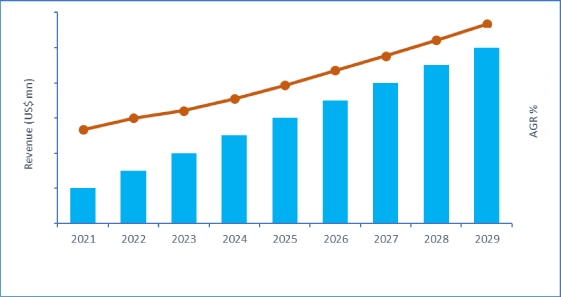The global malaria diagnostics market size is estimated to be USD 825.4 million in 2021 and is expected to witness a CAGR of 6.81% during the forecast period. Increasing demand in malaria-endemic areas for diagnostic tools is a key driver for the growth of the global malaria diagnostics market. Additionally, growth in technological development for efficient diagnostics and rise is access of efficient diagnostics globally are some of the other drivers propelling the market growth. Nevertheless, rise in demand for low-cost diagnostics instruments and lack of awareness regarding availability of diagnostic tools in the developing regions are expected to restrain the global market growth.
Global Malaria Diagnostics Market Size (USD Million), 2021-2029

Source: Erevna Healthcare
By Technology
Based on technology, the market is categorized into microscopic diagnostics, clinical diagnostics, molecular diagnostics, rapid diagnostic tests (RDTS), and other technologies. In 2021, the microscopic diagnostics segment accounted for the substantial revenue share with lucrative CAGR during the forecast period. This is due to the alternating use of the technique for this disease diagnosis worldwide. The molecular diagnostics segment is anticipated to grow at a profitable CAGR during the forecast period, due to the precise, extremely sensitive, and capable of spotting low parasite count.
Regional Insights
In 2021, Middle East & Africa accounted for the highest revenue share in the global market and is expected to maintain its dominance during the forecast period. This is attributed to the growing investment by the developed economies, major patient population, and increasing focus of WHO to decrease mortality rate in the region. Asia Pacific market is projected to exhibit the fastest CAGR over the forecast period owing to the growing government and corporate investment in healthcare sector, aged population, and availability of skilled labor forces at economic costs, are the major factors in this region.
Competitor Insights
Some of the key players in the malaria diagnostics market are AstraZeneca (U.K.); Boehringer Ingelheim (Germany); Bristol-Myers Squibb Company (U.S.); Eli Lilly and Company (U.S.); Genentech, Inc. (U.S.); GlaxoSmithKline plc (U.K.); F. Hoffmann-La Roche AG (Switzerland); Merck & Co., Inc. (U.S.); Pfizer, Inc. (U.S.); and Ventana Medical Systems, Inc. (U.S.). The leading players operating in the malaria diagnostics industry are adopting various strategies including R&D investments, adaption of advanced techniques, new technology launches, mergers & acquisitions, and regional expansions to capture a maximum revenue share.
This exhaustive research report focuses on market size and forecast at global, segmental, regional and country level along with key market trends and dynamics from 2021 to 2029. The malaria diagnostics market report is categorized into the following segments and subsegments:
Malaria Diagnostics Market, By Technology (Revenue, USD Million, 2021 – 2029)
- Microscopic Diagnostics
- Clinical Diagnostics
- Molecular Diagnostics
- Rapid Diagnostic Tests (RDTs)
- Other Technologies
Malaria Diagnostics Market, By Region (Revenue, USD Million, 2021 – 2029)
- North America
- U.S.
- Canada
- Europe
- Germany
- France
- UK
- Spain
- Italy
- Russia
- Rest of Europe
- Asia Pacific
- China
- Japan
- India
- Australia
- South Korea
- Rest of APAC
- Latin America
- Brazil
- Mexico
- Argentina
- Rest of LATAM
- Middle East & Africa
- South Africa
- Saudi Arabia
- Rest of MEA
Scope of Malaria Diagnostics Market Report:
| Key Parameters | Details |
|---|---|
| Base Year |
|
| Forecast Period |
|
| Study Coverage |
|
| Qualitative Analysis |
|
| Regional Market Scope |
|
| Company Profiles |
|
| 15% Free Customization Available |
|




